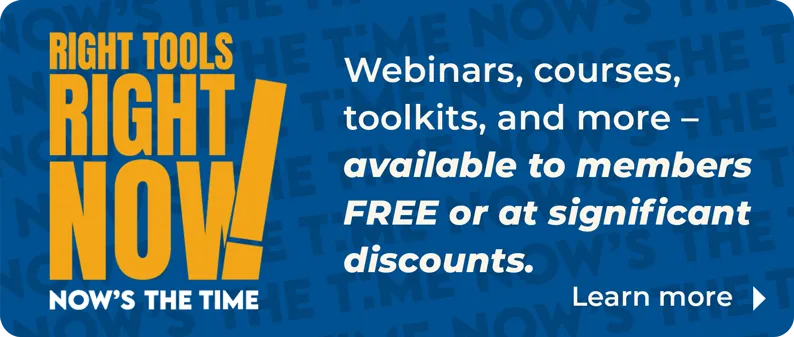How new technology tools and innovations will impact Realtor® associations.
A conversation with Mark Lesswing, vice president of NAR’s Center for Realtor® Technology on how technology tools and innovations will impact associations.
Wi-Fi Ready
What impact will Wi-Fi computing have on associations?
Wireless connectivity has become an integral part of every day business for members. Therefore, it is essential for associations to demonstrate that they are "connected."
Associations with Wi-Fi capabilities in their offices can allow committee and board members at on-site meetings to access materials from their own laptops. At off-site meetings, the association can sponsor "hot spots" that allow members to gain access to the Internet. The CRT sponsors hotel “hot spots” so that volunteering members can stay connected with their business while volunteering their time to the association.
[Hotel and convention center charges for Wi-Fi vary widely, but generally range from $1,000 to $2,000 for several days. Paul Webster, information technology director at the Chicago Association of Realtors®, says his organization’s high-end, Cisco Wi-Fi in-office network cost roughly $3,000 for the hardware, software, and installation. "Smaller associations could install a Wi-Fi system for as little as $500," says Webster.]
Useful Blogs
Is there a use for blogs at associations?
A blog is basically an online journal. Bloggers post information and opinions on the Web and sometimes even allow others to post responses. Blogging software is simple to use and often free.
Associations can use blogs as a low- or no-cost medium for reporting association news, such as the results of committee work, meetings, or class offerings. They can host moderated blogs to solicit discussion from members on association or industry issues, such as marketing tips, VOWs, or brokerage models. Group blogs can be an excellent community-building tool for associations, giving members their own space on the Web for sharing advice, news, links, and ideas.
A key benefit is that the technology is so easy to use. Any AE can update the association’s Web site blog with new information whenever the need arises, so there’s no regular need for a Web master or designer.
Experts caution, however, that corporate blogs allowing readers to post feedback can become a dumping ground for complaints.
[Visit an example of a real estate-related blog online where a Realtor® in Tampa Bay, Fla., posts daily messages about area real estate happenings. For an example of how an association uses a blog, visit the National Association of Manufacturers site.
Digital Imaging
What advances in digital imaging will AEs and members see this year?
A continuing trend in digital cameras will be the availability of versions with more mega-pixels (or resolution). A less publicized but growing aspect of digital imaging is new software that enables users to manipulate images to watermark or tag photos.
Modern digital cameras store metadata in addition to the image data within the image file. The standard for storing such metadata is called EXIF. By using the EXIF field found in images, members can mark their listing photos with ownership information and better track where that photo may appear on the Web without permission. An example of this technique can be found in CRT’s NoScrape tool, which tags images with EXIF before transmission over the Web. Other software that allows editing of EXIF fields in images includes PhotoShop, IMatch EXIF Editor, and likely the software that came with your camera. When purchasing a digital camera, look for a model that allows for EXIF editing.
Switch to VoIP
When should we see associations beginning to switch to VoIP?
Voice over Internet protocol (VoIP) uses broadband lines, rather than traditional phone lines, to transmit phone calls. Many predict it will become the standard for voice communications in the not-too-distant future.
For associations, the technology is economical and efficient. Since it uses existing data lines for voice traffic, it is especially beneficial for associations with multiple phone lines or a large volume of long-distance or international calling. E-mail and voice mail can all be stored in one “in-box” on computers, and with the click of a mouse, all communications -- voice, fax, and data -- can be accessed.
VoIP is currently offered by many local cable television and telecommunications companies. Internet service providers (AOL, MSN, and Yahoo) are also poised to join trail blazers like Vontage in the rapidly growing VoIP market.
[The Orlando and Atlanta Realtor® associations are now in the process of transitioning to a VoIP system. Check out the review of free and paid VoIP plans in the Feb. issue of PC Magazine online.]
Stop Spam
What new types of tools will help associations battle spam?
From a vendor perspective, fighting spam is still a disorganized battle. New tools and filters come out practically every day, but you need to have some level of technical proficiency to use, maintain, and update them regularly. While built-in filtering on e-mail clients such as Microsoft Outlook can filter out unwanted messages, they also have high occurrences of blocking legitimate e-mails. Unless users update the filter settings, important correspondence can be lost.
Regulatory efforts, such as the CAN-SPAM act, provide only marginal relief from the problem. However well-intentioned, legislation and regulation are having a hard time keeping pace with the ever-changing Internet.
But there is good news on the horizon. Information technology providers are working together to create worldwide standards for recognizing spam and certifying legitimate e-mail. However, standards require the cooperation of competitive players and substantial development time before they can be brought to market. We should start to see relief in about four years.
Improve Security
What are the best types of data security tools for associations and members?
Several approaches to securing data were published by CRT last summer in a white paper titled, "Fighting Listing Theft"
Since the paper was published, new approaches to preventing unauthorized access to data have been introduced to the market. One is called "authentication token technology." For MLS access, for example, members would have a physical token (it fits on a keychain) with a digital readout that changes every minute. When they want to log in to an MLS, they provide the number on their token as their password. Both the MLS server and the token know the changing numbers, but an outsider doesn’t. While this new technology can be expensive to implement, prices are expected to drop in 18 to 24 months.
A lower-cost approach to data security would be for associations and MLSs to strengthen password policies. Most security breaches involve data being passed outside of the Realtor® community by someone who has legitimate access to it.
CRT has used marking and seeding techniques with one local association’s MLS to ferret out listing piracy. While association officials knew they had a problem, they could not afford expensive technological fixes. We suggested some techniques, now published in a management guide, that enabled the association to easily determine who was responsible for the theft and how to stop it.
MLS Advances
What innovations in MLS software or programs should associations implement this year?
Associations should encourage their MLS operations to adopt two important standards: Real Estate Transaction Standard (RETS) and Realtor® Secure.
RETS is a very good first step toward the seamless copying of listings from the MLS to brochures, marketing materials, and in-house transaction management systems. These “cut and paste” efforts constitute some of the most time-consuming activities in real estate offices. If data standards were supported by vendors, manual processes would be reduced. If more MLS operations demanded RETS support, more vendors would comply, providing a huge service to members. CRT’s newly released RETS server software, Variman, is a step in that direction.
Realtor® Secure is also an important program because it certifies that MLSs and associations are using best practices in the technical operation of Internet-based systems.
New CRT Offerings
What activities and projects does the CRT have planned for the coming year?
This year, CRT is creating tools that are not only better focused on user needs but actually more likely to get to market faster.
The projects include Policy Page, an application to automate the Web site review process for associations checking for compliance with MLS display policies, and a new suite of Microsoft Office desktop tools that will help Realtors® gather and analyze data more effectively. CRT is also in the process of researching best practices for getting the most out of your Web presence and increasing your rank in search results.








